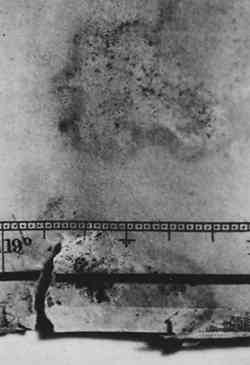A STUDY OF THE REMOVAL AND PREVENTION OF FUNGAL STAINS ON PAPERHANNA SZCZEPANOWSKA, & CHARLES M. LOVETT
1 INTRODUCTIONFungi growing on paper art objects affect the surface characteristics of the artwork primarily by producing, and often secreting, a variety of pigments. Surface characteristics will also be affected to varying degrees due to the fungal digestion of the cellulose fibers. Fungal pigments are typically composed of many complex chemical substances that are formed during metabolic processes; these pigments may be encrusted in spores, present in mycelium (the mass of filaments constituting the body of the fungus), or secreted to a substrate such as paper. An example of a paper artwork, an early 19th-century map that was damaged by fungal growth, is shown in figure 1. The section of the map depicted exemplifies all types of damage that can be caused by fungi: staining, degradation of cellulose fibers (resulting in tears), and residue embedded in the paper. While fungal damage presents a very serious problem to paper conservators, there are presently no effective methods for local, nonaqueous removal of fungal
This study addresses a fundamental problem that faces paper conservators: the need for a repertoire of practicable methods for removing fungal stains from paper (Szczepanowska 1986; Sczepanowska and Lovett 1988). Because the stains produced by different fungi are chemically distinct and therefore respond differently to any given treatment, it is important to define removal methods for stains produced by individual fungi. With this in mind, we developed a simple methodology for studying the removal of stains produced by specific fungi. Briefly, this methodology involves growing a known fungal strain aseptically under conditions that result in intense paper staining in a few days. The paper thus stained can be subjected to removal techniques systematically in order to identify effective techniques for a particular fungal stain. Clearly, it would be desirable to have a catalog of stain removal techniques, classified according to individual fungi, so that a conservator could use the appropriate method for an identified fungal strain. We describe a means toward such a classification that obviates experimenting on artworks themselves. Our investigation focused on four fungal species that are frequently found on artworks in this climate and are responsible for the most prominent stains: Fusarium oxysporum, Alternaria solani, Penicillium notatum, and Chaetomium globosum(Strzelczyk 1981). These fungi were selected on the basis of data collected by Szczepanowska during 14 years of restoring artworks infested by fungi. It should be noted that these are not the only fungi that infest paper artworks and the methods we describe could be applied to the growth and analysis of stains produced by any known fungal strain. We explored the effect of various solvents in removal of fungal stains. This method provides a potentially quick and effective means for paper conservators to treat artworks discolored by fungal pigments. Although we have by no means exhausted potential solvents, our results suggest possible approaches to the conservation of paper artworks damaged by these particular fungi. Not surprisingly, we found that the individual fungal stains respond differently to various treatments thus demonstrating the need for stain-specific removal techniques. The search for such removal techniques should be facilitated by the rapid growth and staining method decribed in this article. The ability to grow a particular fungi rapidly under conditions that result in stain production also affords a way to assess the effects of certain environmental conditions on fungal growth and stain production. Using our method of fungal growth under aseptic conditions we can easily alter parameters such as pH, temperature, and light exposure—factors that are known to affect fungal growth (Wolf and Wolf 1947). We report here the effects of these factors, under our growth conditions, on both fungal growth and stain production. Our results are consistent with previous studies showing that varying these parameters affects growth rate and pigment production for a variety of fungal strains (Hulme and Stranks 1976; Linfield 1986; Nol et al. 1983; Verona 1969; Wolf and Wolf 1947). This type of analysis should help to determine appropriate stronge conditions that would minimize fungal destruction of paper artworks. Unfortunately, it is not possible to examine the effects of humidity (probably the single most important factor affecting fungal growth) using our growth procedure; fungi are grown in covered Petri dishes, containing agar, where the humidity is expected to be very high (nearly 100% RH while the agar is wet). |
